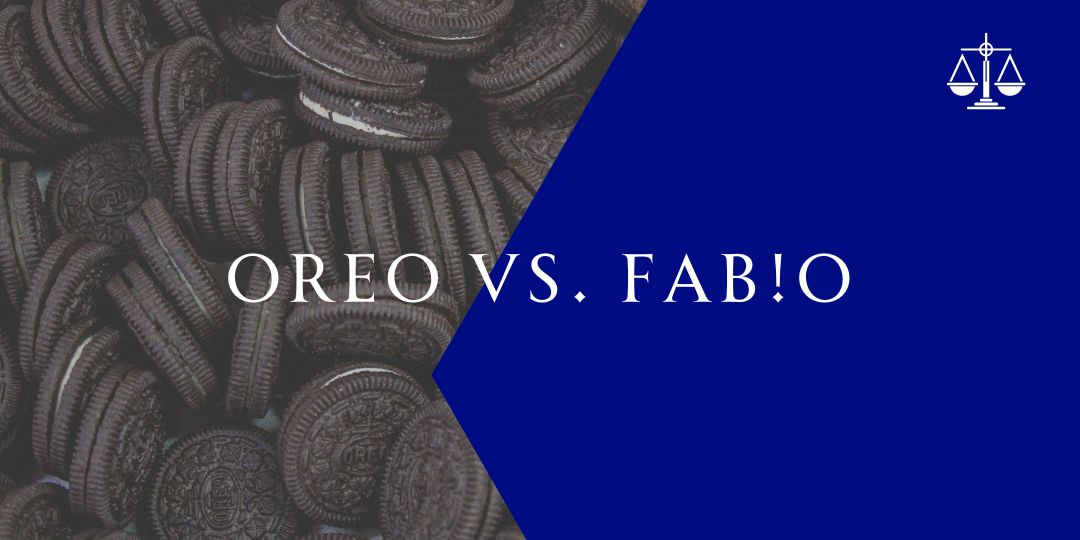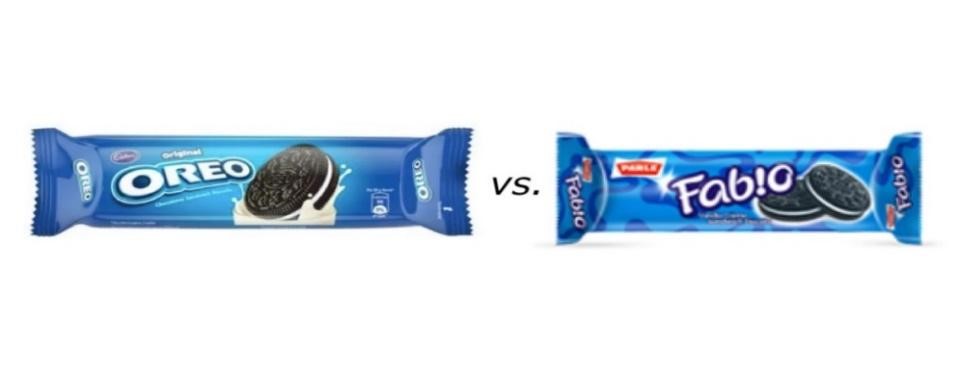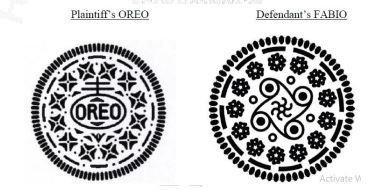Parle loses its battle against Cadbury before the Delhi High Court and restrained from manufacturing and selling its FAB!O Biscuits

P. Saranya
Senior Associate, IP Practice
In the modern era, Advertising plays a significant role for the reach and success of a product among the common public. People before coining/adopting a brand always use their intellect to develop the products which are distinctive and unique in nature and have not been in the market earlier. This Article will give you the complete details about the concept of trade dress and its infringements in India. Here is the case of “The Intercontinental Brands v Parle product pvt ltd” [2023 DHC 953] wherein the Hon’ble High Court of Delhi restrained the Defendant from using the impugned FABIO or FAB!O mark for any purpose whatsoever and for manufacturing, packing or selling their vanilla cream filled chocolate sandwich biscuits in the impugned pack or using the impugned trade dress.

(Source: https://www.trademarkiso.com/ip-battle-of-biscuits-oreo-vs-fabio/)
A Case filed by the Plaintiff under Order 39 Rule 1 and 2 of the Code of Civil Procedure, 1908
Facts of the Case:
The Plaintiff, Intercontinental Great Brands has filed the present suit (trademark infringement case)seeking injunction against the defendant Parle Products Private Limited from using its FAB! or FAB!O marks which is phonetically similar to the plaintiff’s OREO mark and from manufacturing and selling its vanilla cream filled chocolate sandwich biscuits in the impugned pack and impugned trade dress which is deceptively similar to the trade dress of the plaintiff’s OREO biscuits and biscuit packaging. The Defendant Parle had introduced its Fabio biscuits in January 2020 in two flavours, vanilla and chocolate cream filled chocolate sandwich biscuits, while Oreo was launched in India by the Plaintiff Mondelez nearly 10 years before (i.e.) in 2011 taking its pace into the biscuit category in India. The Plaintiff herein has indicated that the trade dress of the package in which the defendant sells its vanilla cream filled biscuits is deceptively similar to the trade dress of the plaintiff’s OREO package, whereas the package in which the defendant sells its chocolate cream filled biscuits is of a different colour which proves the defendant’s malafide intention to imitate and trade upon the goodwill and reputation of the Plaintiff’s OREO mark and packaging which is well-known in the market. The plaintiff further alleges infringement and passing off by the defendant of the design of its OREO biscuit for which the plaintiff owns the earlier registration under the Trademarks Act, 1999.
Issues of the Case:
i) Is the instant mark OREO and the impugned mark FAB!O/FABIO phonetically similar?
ii) Whether the trade dress of the rival packaging is deceptively similar?
iii) Is the design of the cookies deceptively similar?
i) Is the instant mark OREO and the impugned mark FAB!O/FABIO phonetically similar?
The Defendant in this case through its advertisement in its facebook page says that the word FAB!O is to be pronounced as fab-ee-yo as verbally similar to the Plaintiff’s OREO. Phonetic similarity, therefore, stands admitted by the defendant themselves. The two concluding syllables of the three syllables of the rival marks which constitute in each of the words FABIO and OREO being the same, i.e. ee-yo, therefore the rival marks indisputably rhyme alike. The court therefore said that the argument by the Defendant based on the dissimilarity between the first syllables of “FABIO” and “OREO” cannot be accepted as there are binding judicial precedents which have held that the marks are phonetically similar even though some of the syllables if appears different and, as a result likely to confuse or deceive the common public.
The Court here in the present suit referred to the case of Amritdhara Pharmacy v. Satya Deo Gupta (1963) 2 SCR 484, wherein the Court held that the mark Amritdhara to be phonetically similar to Laxmandhara and further in the case of Pankaj Goel v. Dabur India Ltd held the marks HAJMOLA and RASMOLA to be phonetically similar. Thus, the plea of the Defendant’s Counsel Mr. Sethi who established that there is dissimilarity between the first syllables of the rival marks FABIO and OREO, therefore not accepted.
ii) Whether the trade dress of the rival packaging is deceptively similar?
The similarity in the features of the FAB!O and OREO packaging which are as follows:
- a blue and white colour scheme with an overall blue background,
- slanted placements of the OREO and FAB!O terms on the pack
- the words OREO and FAB!O written in white letters with a blue outline,
- the packages being similar in size.
The Defendant herein had contended that the packing of blue and white colour combination is common to trade in the biscuit industry and thus there is no question of deceptive similarity on the basis of overall appearance of the packs. The court ruled that the differences between the two packages aren’t enough to convince a customer with average intelligence and poor memory that the biscuits are made by two different entities in relation to similar trade dresses.
The bench stated that, “Commonality to the trade, statutorily, is not a defence against infringement, though curtails the plaintiff’s right” in response to the defendant Parle’s arguments. According to the Trade Marks Act, Section 17(2)(b), no part of a trademark that is common to the trade can be claimed to be exclusive.
In assessing the infringement, one compares the rival trademarks to check whether they are so similar to each other as to lead to confusion or deception, as envisaged by Section 29. On the Contrary, passing off is a common law tort under Section 27(2) of the Trade Marks Act as an independent right available to the user of a mark, registered or unregistered. The Plaintiff herein contended that the packaging of the Defendant’s FAB!O Cookies is deceptively similar to that of Plaintiff’s OREO Cookies. All the essential features and elements were blatantly copied by the defendant and thus by analysing the principle of “initial interest confusion” the Court came to a conclusion that the sales of the rival cookies in the market shall lead to confusion among the public and cannot distinguish the products between the competing marks.
The Court held that “A consumer of average intelligence and imperfect recollection who has earlier purchased and had the Oreo cookie would, when he sees the Fab!o cookie pack, be clearly likely to associate the Fab!o cookie with the Oreo cookie that he had earlier enjoyed” and hence the Hon’ble court granted the interim injunction against the Parle from using FAB!O
iii) Is the design of the cookies deceptively similar?
The Plaintiff alleges that the Defendant herein has infringed the design of the plaintiff‘s OREO cookie for which the plaintiff holds a subsisting trademark registration. The Counsel pointed out that the (i) outer ridge, (ii) inside dashes just inside the circumference, and (iii) florets-shaped embossing are features which are common to the designs of both the biscuits. With regard to the surface designs of the biscuits are concerned, the registration held by the plaintiff clearly discloses the shapes of the individual florets as well as the prominent term OREO in an elliptical enclosure towards the centre of the biscuit. The design of the defendant‘s FAB!O cookie has no such elliptical enclosure or any logo whatsoever on its surface; the florets are distinct and different in shape and the overall appearance of the surface design is also different.

(Source: https://images.assettype.com/barandbench/2023-02/dcd221c7-fea9-402b b409-c29049ebe115/Intercontinental_Great_Brands_v_Parle_Product_Private_Limited)
The mere existence of a ridged outer surface and an outer border consisting of dashes cannot render the two designs confusingly or deceptively similar. To a person of imperfect recollection too, the design of the FAB!O biscuit cannot be regarded as confusingly similar to that of the OREO biscuit. Infringement has to be assessed by comparing the marks feature by feature and thus concluding that the surface design of the defendant‘s FAB!O biscuit is not deceptively similar to the registered design of the plaintiff‘s OREO biscuit.
Cases referred by the Court:
- Amritdhara Pharmacy v. Satya Deo Gupta (1963) 2 SCR 484 and Pankaj Goel v. Dabur India Ltd. (2008) 38 PTC 49
- ShreeNath Heritage Liquor Pvt. Ltd. v. Allied Blender & Distilleries Pvt. Ltd. (2015) 63 PTC 551
- Slazenger & Sons v. Fletham & Co. (1889) 6 RPC 531
- Britannia Industries Ltd. v. ITC Ltd. (2021) 86 PTC 61
- Manikchand Dhariwal v. M.S.S. Food Products, (2012) 2 SCC 196
Findings of the Court and Verdict:
In light of the above findings and discussions, the Court declared that the defendant herein has prima facie infringed the registered trademarks of the plaintiff by adopting a trade dress which is deceptively similar to that of the plaintiff‘s instant OREO cookies and thus sought to pass of its FAB!O vanilla cream filled chocolate cookies so as to deceive the common public and to create an association with the plaintiff‘s OREO cookies and thus the defendant was restrained from using the impugned FABIO or FAB!O mark for any purpose whatsoever and restrained from manufacturing, packing and selling its vanilla cream filled chocolate sandwich biscuits in the impugned pack or using the impugned trade dress.
Analysis:
As to the brief understanding of the above case, it is to be noted that there is an absence of certain legislations protecting trade dress in India in particular. There is only a provisional recognition of trade dress in the trademarks act under Section 2. But, the US is the first country to recognize the concept of Trade dress under Section 43(a) of the Lanham Act by regulating the trademarks as well as trade dress. In the recent years, there have been numerous occasions in India wherein trade dress has been the subject of passing off actions. Section 2(m) of the Trade Marks Act 1999 defines the term “mark” as it also includes the shape of goods, packaging, or combination of colours. This new definition is wide-ranging and takes into account the concept of trade dress. The principle for instituting the infringement of trade dress was for the very first laid down in the case of Colgate Palmolive Company and Ors. vs. Anchor Health and Beauty Care Pvt. Ltd. (29.10.2003 – DELHC) : MANU/DE/1000/2003 wherein the Court held that, on the fact that for the purposes of determining any infringement, the overall similarity in the product packaging should be taken into consideration and not the dissimilarity in any manner. It was also established that the presence of any actual confusion is not necessary as the mere likelihood of confusion is sufficient for proceeding with the action of passing off. Further, in the case of and Atlas Cycle Industries Ltd. v. Hind Cycles Limited the Court held that by demonstrating that the defendant’s mark is identical to the plaintiff’s mark, either visually or phonetically which can confuse the customers, the protection to the trade dress of the original owner will be decided by the Court. Even if the other party has adopted a few additional distinctive features on a similar mark, that becomes irrelevant in an infringement suit.
The Bombay High court in the case of Merwans Confectioners Pvt Ltd v. M/s Sugar Street & Ors. observed that likelihood of confusion is an important factor to determine infringement of trade dress.
Conclusion:
It can be fairly concluded that the concept of trade dress is still in the process of evolving in India and the judiciary plays a key role in the emergence of the law in relation to trade dress. Also the trade dress conception is gaining global recognition with the states and their judicial system incorporating and interpreting it in their trademark protection laws. With the advancement of technology and globalisation, the extent of protection of products needs to be prolonged. With the occurrence of intense competition in the market, it has become substantial to protect the rights of the product owners. While most of the countries have recognized trade dress as a noteworthy concept, India lags behind. The trade dress protection is available for designs, shapes and colour combinations etc. Protecting trade dress is imperious as it helps in providing a distinctive characteristic/feature to the products in the markets which helps the end consumers in identifying and distinguishing them from the other products in the market. Also, the scope of trade dress protection is fairly broader than the protection offered by the trademark law. This can be accredited to the fact that trade dress protection not only protects the design of a product and packaging but it also lays emphasis on the overall brand value of the product.
References:
https://insaaf99.com/temfiles/intercontinental-great-brands.pdf
https://excelonip.com/cadbury-oreo-vs-parle-fabio-case-summary/
https://markshield.in/intercontinental-great-brands-vs-parle-product-private-limited/
https://www.lexology.com/library/detail.aspx?g=85f7a092-7242-46e5-b71a-fb77fb5db112
https://www.lexology.com/library/detail.aspx?g=e25dbd9f-454a-4e4c-861c-d99c2c07fab6



